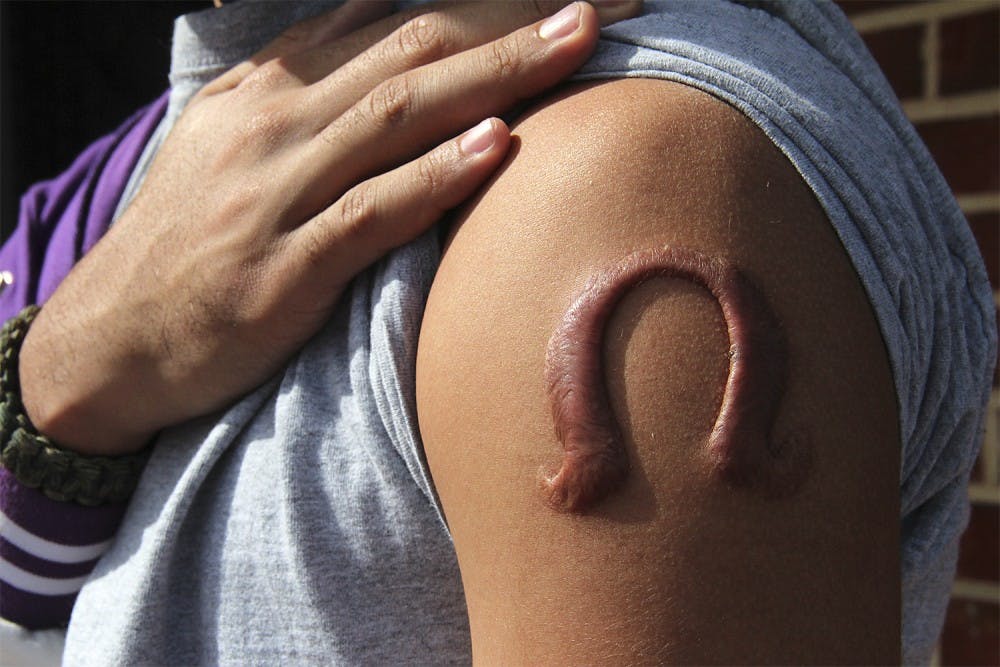“The annoying part is the healing afterward and not the application of the brand,” he said. “Applying it actually hurts less than some tattoos, which you could be receiving for hours at a time potentially.”
Beckett said every person’s skin reacts to the burn differently. For some, it creates a flat scar that fades more easily over time. In his case, it created a raised scar called a keloid scar that he said took three to four months to heal.
Cairns said in addition to typical burn complications such as infection, scars like Beckett’s can itch, tighten the skin or be prone to bleeding.
D. Michael Lyles, the executive director of the Human Relations Commission of Prince George’s County in Maryland and member of Omega Psi Phi’s Grand Officers, said he was branded on two separate occasions while in college — on his biceps and over his heart.
Lyles said the one on his arm has faded over time, but deeper burns tend to last longer.
“A lot of brothers I know from the sixties can still see the outline of them,” he said.
University policies
In the five years since Aaron Bachenheimer has been at UNC, he has only received one complaint about branding. It came from a concerned parent of a fraternity member who came home with a brand.
Although, historically, there have been students at UNC that have been branded, it is not something Bachenheimer, director of Fraternity & Sorority Life and Community Involvement at UNC, and his department encounter often.
“In that instance there was nothing to handle,” he said. “Typically branding doesn’t happen until one is initiated, but historically it is not a part of hazing.”
He said the administration is aware of branding in UNC Greek life, but because it is a voluntary practice, there are no official policies against it.
“While we may have concerns about branding, particularly the process which can lead to other problems, we can only educate people about branding,” Bachenheimer said.
To get the day's news and headlines in your inbox each morning, sign up for our email newsletters.
Bachenheimer said he has not heard much about branding in practice for almost two decades.
Though there is no official UNC policy, if branding is a part of hazing, it is dealt with in a different capacity.
This side of branding was brought into the national spotlight when a student at Texas Christian University said his Kappa Sigma brothers branded him while he was passed out at a party in 2010.
“If the brand itself is incurred through another act of violence, then we have an assault policy but not a branding policy,” Bachenheimer said.
A voluntary practice
Lyles said the tradition started in National Pan-Hellenic Council fraternities around the 1960s, though it developed at different fraternities across the country parallel to one another.
Eddie Francis, who studies historically black colleges and universities and the National Pan-Hellenic Council, said there is no way to know exactly the beginning of branding in NPHC organizations because there is not much documentation on the subject.
Sandra Posey, a women’s studies associate professor at the Metropolitan State University of Denver who has studied the Omega Psi Phi fraternity, said she has heard various stories that trace it back to black soldiers in World War I, the branding of slaves, African practices or even a freemason tradition.
“So much is veiled in secrecy and legend,” she said. “It’s really hard to say what the actual origin of branding in fraternities is.”
Even now the organizations practice discretion among other organizations in the Divine Nine — the nine historically black Greek letter organizations in NPHC — so it is hard to know what happens in the fraternities and sororities.
“Discretion is something that is not only a requirement but is respected,” Francis said.
Lyles said that along with Omega Psi Phi, chapters of Kappa Alpha Psi Fraternity, Inc. and Alpha Phi Alpha Fraternity, Inc. have their own branding traditions.
“For us it was ceremonial, but it is certainly not sanctioned by the fraternal organizations,” he said.
Bachenheimer said NPHC fraternities usually have a policy that explicitly states the national organization’s official stance on branding.
Members say practice is a voluntary decision and not part of any hazing or initiation rituals.
Georgia State University alumnus Anthony Kadri is a member of Omega Psi Phi and serves in the national organization’s Grand Council. Kadri said while others in his chapter have gotten branded, he chose not to, in part because he has a skin condition.
“I think I like my clean skin, no piercing or anything like that,” he said.
Beckett said its important to get branded by someone who knows what they are doing, both to ensure it looks correct after and to reduce the risk of complications.
“It is like a tattoo in the way that you’re not just going to let anybody do it,” Beckett said. “You ask around and see who can do it well, and those people become pretty popular within the fraternity.”
Kadri said because it is not a sanctioned activity, members need to use common sense when they get branded.
“It’s a burn,” he said. “You’re assuming your own risk. You’re not forced to have one.”
Branding is mostly about expressing love for the organization, according to Francis.
“Emotional attachment, if you look outside of branding, is no different from how other people show attachment,” he said.
special.projects@dailytarheel.com




